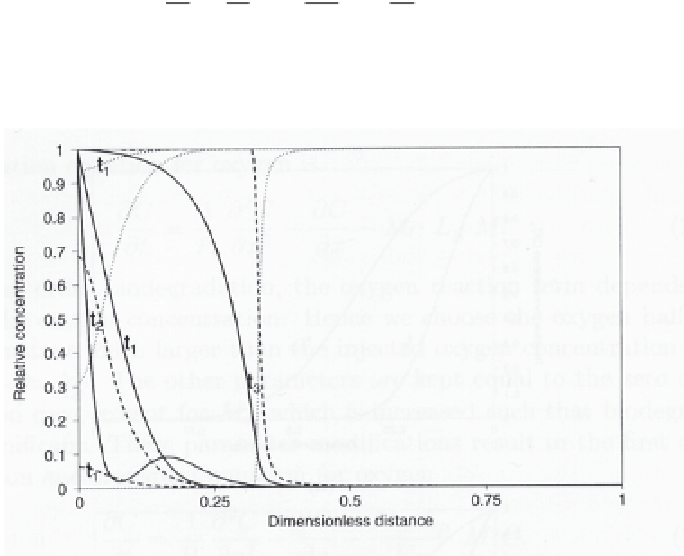Agriculture Reference
In-Depth Information
q
2
c
c
c
+ = D
v
k
c
q
(4)
2
t
t
x
x
Where
q
is adsorbed amount,
c
is concentration,
k
is degradation rate,
v
is pore velocity,
D
is
dispersion coefficient,
θ
is volumetric water fraction,
ρ
is density.
Fig. 6. Concentration distributions for electron acceptor (solid), contaminant (dotted), and
microbial biomass, for times increasing in the direction of t
1
to t
3
. Concentrations scaled with
regard to their maximum concentration.
In essence, according to this transport equation, adsorption/desorption is instantaneous,
and the degradation occurs (according to the last term) both in the liquid and in the solid
phases. In terms of system properties, physical properties such as the hydraulic conductivity
and water retention, control the development in time of the volumetric water fraction ()
and flow velocity (
v
). Biogeochemical properties of importance are those related with the
adsorption equation, s(c), e.g. affinity coefficient and a sorption maximum, and those related
with the degradation rate, e.g. Monod kinetics parameters that describe the degradation rate
as a function of the concentrations of contaminant, of electron acceptors or reductors, and
microbial activity. Commonly, degradable contaminants are assumed to degrade according
to first order kinetics. For the given transport equation, the transport and leaching process
can be simulated with a computer model such as PEARL (Leistra et al., 2000). The PEARL
model considers one-dimensional transient flow of water in the soil (vadose zone) profile,
which is linked to the convection dispersion equation (CDE) for transport of chemicals.
Besides that the model has modules for crop growth and energy and water interactions with
the atmosphere, it is also possible to account for (monocomponent) adsorption/desorption
and first order degradation. The PEARL model(see Beltman et al., 2008) is used in pesticide
screening in the EU, for which the FOCUS scenarios have been developed ((FOCUS, 2000).).
These scenarios harmonize the soil type, climate and weather variations within the EU for
which the assessment of pesticide leaching to groundwater is evaluated, with several aims,
among which the need to consider a limited number of modeling permutations, while still
enabling comparison of results EU-wide.


